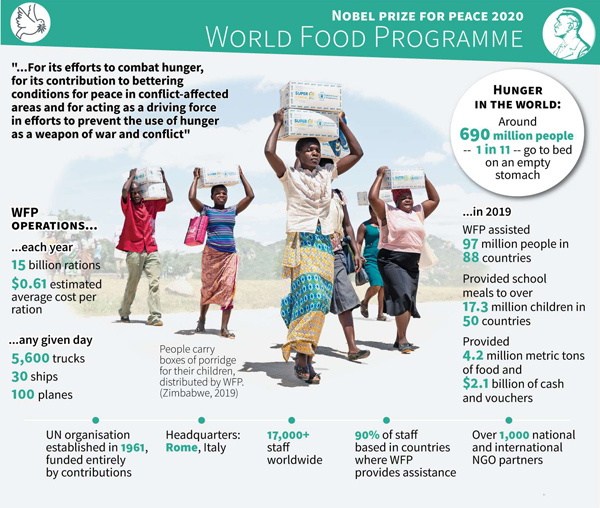International Relations
India and WFP to Supply Wheat to Afghanistan
- 14 Feb 2022
- 7 min read
For Prelims: United Nations World Food Programme, Humanitarian Assistance, Food and Agriculture Organisation, Nobel Prize, Global Report on Food Crisis.
For Mains: Inclusive Growth,India and its Neighbourhood, Important International Institutions, Food Security, Effect of Policies & Politics of Countries on India's Interests, India and WFP, WFP and its Significance.
Why in News?
Recently, India signed an agreement with the United Nations World Food Programme (WFP) for the distribution of 50,000 MT of wheat that it has committed to sending to Afghanistan as part of a humanitarian assistance.
- Earlier, the Delhi Regional Security Dialogue on Afghanistan was held. The meeting called for “urgent humanitarian assistance” to the Afghan people and urged close cooperation and consultation among the regional countries over the Afghan scenario.
- In 2020, India sent more than 20 tonnes of medicines, other equipment and transported 75,000 tonnes of wheat to Afghanistan to address the Covid-19 challenge.
What is the Wheat Agreement About?
- The wheat will be taken through Pakistan to the Afghan border crossing and handed over to WFP officials in Kandahar beginning February 2022.
- Iran has also offered to facilitate some of the wheat through Chabahar port and then on to Afghanistan’s border via Zahedan.
What is the Major Concern in Fulfilling the Agreement?
- The route via Pakistan, which has been closed for all exports from India since 2019, and opened only as an exception, is likely to require several weeks for the transport of the current consignment, as infrastructure and labour required to load and reload the wheat has to be organised.
- Pakistan had shut down all trade with India to protest the government’s changes in Jammu and Kashmir and Article 370 in August 2019.
- Subsequently, the Pakistan government had allowed Afghan exports to India to pass through the Wagah border, making an exception also for medicines from India during the pandemic.
- India has also flown several consignments of medicines and medical equipment to hospitals in Afghanistan on board flights.
What is the United Nations World Food Programme?
- About:
- The World Food Programme (WFP) is the leading humanitarian organisation saving lives and changing lives, delivering food assistance in emergencies and working with communities to improve nutrition and build resilience.
- It was founded in 1961 by the Food and Agriculture Organisation (FAO) and United Nations General Assembly (UNGA) with its headquarters in Rome, Italy.
- It is also a member of the United Nations Sustainable Development Group (UNSDG), a coalition of UN agencies and organisations aimed at fulfilling the Sustainable Development Goals (SDGs).
- The WFP assists 88 countries, and has assisted 97 million people (in 2019) which is the largest number since 2012.
- The WFP has been awarded with the Nobel Prize for Peace 2020 for its efforts to combat hunger, bettering conditions for peace in conflict-affected areas and preventing the use of hunger as a weapon of war and conflict.
- Major Objectives:
- To end hunger by protecting access to food.
- Improving nutrition and achieving food security.
- Supporting the SDG implementation and partnering for its results.
- To focus on emergency assistance as well as rehabilitation and development aid.
- Major Reports:
What is the Relation of WFP with India?
- Background: WFP has been working in India since 1963, with work transitioning from food distribution to technical assistance since the country achieved self-sufficiency in cereal production.
- The areas in which WFP mainly assists in India are:
- Transforming the targeted public distribution system: WFP is working to improve the efficiency, accountability and transparency of India’s own subsidised food distribution system, which brings supplies of wheat, rice, sugar and kerosene oil to around 800 million poor people across the country.
- Fortification of government distributed food: To boost the nutritional value of the Government’s Midday Meal school feeding programme, WFP is pioneering the multi-micronutrient fortification of school meals.
- The pilot project saw rice fortified with iron, which was distributed in a single district, resulting in a 20% drop in anaemia.
- It has also helped tackle malnutrition by fortifying food given to babies and young children in Kerala State.
- Mapping and monitoring of food insecurity: WFP has used Vulnerability Analysis and Mapping softwares to identify India’s most food insecure areas, which allows policy and relief work to be targeted appropriately.
- WFP is also supporting the government’s Poverty and Human Development Monitoring Agency in establishing a State-level Food Security Analysis Unit, working towards the goal of achieving Zero Hunger.
- Strategy Plan for India: According to the country strategy plan for India (2019 – 2023), WFP aims to:
- Enable the most vulnerable people of India to meet their minimum food and nutrition requirements throughout the year.
- Enable people with a high risk of malnutrition, especially women, children and adolescent girls, to have improved nutrition by 2025.





